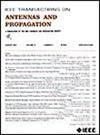A Low-Profile Implantable Antenna for Heart Implants
IF 4.6
1区 计算机科学
Q1 ENGINEERING, ELECTRICAL & ELECTRONIC
引用次数: 0
Abstract
The complex nature of the human body and the interaction between implantable antennas and electronic components can result in detuning issues. A wide bandwidth is critical for mitigating these issues and improving channel capacity. This communication presents a compact implantable antenna that provides ultrawide bandwidth for leadless cardiac pacemakers (LCPs). The proposed antenna has an ultracompact size of 8.33 mm3, with a 10-dB bandwidth of 4.33 GHz (fractional bandwidth of 152.7%), spanning from 0.67 to 5 GHz. It covers the Industrial, Scientific, and Medical (ISM) bands (0.915 and 2.45 GHz), the Wireless Medical Telemetry Service (WMTS) band (1.4 GHz), and the midfield band (1.6 GHz). The simulation results demonstrate gains of −31.3 dBi at 0.915 GHz, −25.8 dBi at 1.4 GHz, and −21.9 dBi at 2.45 GHz. This antenna exhibits peak specific absorption rate (SAR) values of 320.4 W/kg at 0.915 GHz, 332.8 W/kg at 1.4 GHz, and 464.1 W/kg at 2.45 GHz. To ensure the reliability of the wireless communication link, the link budget is analyzed to estimate the range between the transmitter and receiver at data rates of 10 and 25 Mb/s. To validate the results, the manufactured antenna is tested with minced pork, demonstrating a satisfactory agreement between the measured and simulated outcomes.一种用于心脏植入的低轮廓植入式天线
人体的复杂性以及植入式天线和电子元件之间的相互作用可能导致失谐问题。宽带宽对于缓解这些问题和提高信道容量至关重要。该通讯提出了一种紧凑型植入式天线,可为无导线心脏起搏器(lcp)提供超宽带。该天线的尺寸超紧凑,为8.33 mm3, 10db带宽为4.33 GHz(分数带宽为152.7%),范围为0.67至5 GHz。它包括工业、科学和医疗(ISM)频段(0.915和2.45 GHz)、无线医疗遥测服务(WMTS)频段(1.4 GHz)和中场频段(1.6 GHz)。仿真结果表明,在0.915 GHz时增益为- 31.3 dBi,在1.4 GHz时增益为- 25.8 dBi,在2.45 GHz时增益为- 21.9 dBi。该天线在0.915 GHz、1.4 GHz和2.45 GHz频段的峰值比吸收率分别为320.4 W/kg、332.8 W/kg和464.1 W/kg。为了保证无线通信链路的可靠性,分析了链路预算,在数据速率为10和25mb /s的情况下估计发送端和接收端之间的距离。为了验证结果,用肉末对人造天线进行了测试,结果表明测量结果与模拟结果吻合良好。
本文章由计算机程序翻译,如有差异,请以英文原文为准。
求助全文
约1分钟内获得全文
求助全文
来源期刊
CiteScore
10.40
自引率
28.10%
发文量
968
审稿时长
4.7 months
期刊介绍:
IEEE Transactions on Antennas and Propagation includes theoretical and experimental advances in antennas, including design and development, and in the propagation of electromagnetic waves, including scattering, diffraction, and interaction with continuous media; and applications pertaining to antennas and propagation, such as remote sensing, applied optics, and millimeter and submillimeter wave techniques

 求助内容:
求助内容: 应助结果提醒方式:
应助结果提醒方式:


